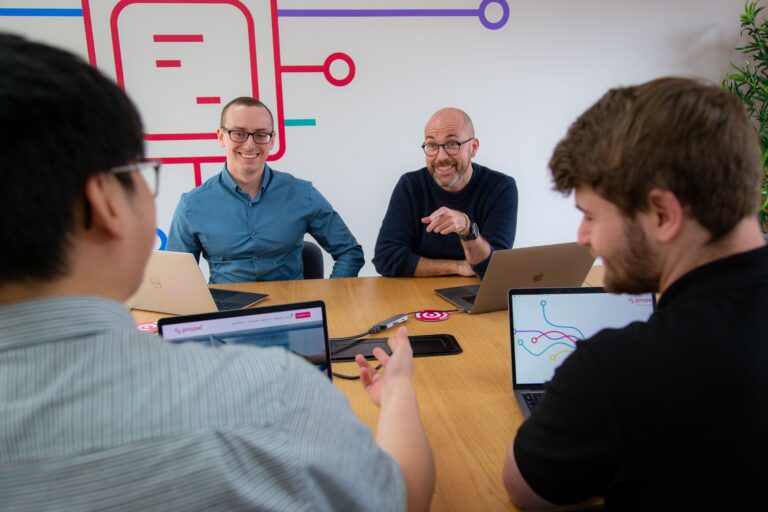A talent review refers to a process of identifying a pool of high-performing and high-potential individuals to fill critical positions that differentially contribute to the organization’s sustainable competitive advantage. Talent reviews are essential because many organizations continue to struggle to fill critical positions, which, subsequently, may hamper their potential to grow (Ready & Conger, 2007).
1. Components of a Talent Review Process
There are typically five components of a talent review process.
- Talent profile: A talent review process must begin with the creation of a talent profile for the employees in the organization. A talent profile is an online Curriculum Vitae completed by each employee (Burbach & Royle, 2010). This becomes a foundational document for the talent review process.
- Talent evaluation: Next, stakeholders (i.e., organizational leaders, line managers, managers, HR business partners, and talent managers) need to evaluate each employee under consideration in the talent review process. Specifically, the idea is to get all stakeholders to engage in conversations about the data captured in the talent profile of each employee. The eventual outcome of such conversations should be a unanimous agreement on each employee’s growth potential, areas of development, and feasible future roles that align with the employee’s career aspirations.
- Talent Identification: Having captured the potential, development areas, and feasible roles of each employee, the stakeholders will now proceed to place employees in one of the nine categories of the 9-box model.
- Succession Planning: The stakeholders are now ready to move to the centerpiece of the talent review process—succession planning. Succession planning is the process of identifying successors for each critical position in the organization. For each such critical position, stakeholders need to look at the following categories of successors:
- A successor who is ready now: The employee can take up the role immediately.
- A successor who can be ready in a year or two: With focused development inputs and resources, the employee can become ready in a year or two.
- A long-term successor: A high-potential employee who is being groomed and developed to leadership positions over the span of three to five years.
- Talent conversations: To ensure a transparent talent review process, it is vital to provide feedback and development inputs to the employee. The talent conversation is a collaborative approach between managers and employees to build rapport, give and seek authentic feedback, mutually commit to development actions, and provide direction on future roles within the organization.
2. Measuring the Effectiveness of a Talent Review Process
Organizations should also track whether the talent review process completed in the current cycle was indeed successful, and what areas can be further improved upon when launching the next cycle of the process. There are three types of measures to track process success: input, output, and outcome. These three levels of measurement are essential as they help an organization understand if it’s focusing on the right talent practices (input), have those talent practices been implemented correctly (output), and, finally, have those talent practices moved the needle for the organization and delivered results that matter (outcome). Some of the common metrics to track the effectiveness of a talent review process are depicted in Table 1.
Table 1: Assessing The Effectiveness of a Talent Review Process
| Category of measures | Definition | What does it measure? | Examples of measures collected |
| Input | Answers the question: Are we doing the right things? | Tasks and activities completion |
|
| Output | Answers the question: Are we doing things, right? | Achievement /results |
|
| Outcome | Answers the question: What is the change status? | Desired end state or objective |
|
While a variety of talent metrics may demonstrate the success or failure of a talent review process, we have suggested in Table 1 a few measures under the input, output, and outcome levels because of their specific importance as delineated below:
- The absolute number/percentage of top talents is significant because it helps senior leaders understand the total number of top talents as compared to last year or the percentage of top talents versus the overall employee strength. By improving the quality of hiring and providing focused development, this number should ideally show an upward trend.
- Adherence to the succession plan demonstrates the discipline of an organization in moving the identified successors to the target role when an opportunity arises. It shows the actual strength of the succession pipeline.
- The number of successors demonstrates the strength of the succession pipeline in terms of the number of candidate options available for a given role.
- Internal talent mobility gives a snapshot of how an organization supports internal movements and, thus, provides newer roles and unique learning experiences to top talents.
- A robust talent review process should result in a reduction of cost per hire as the organization does not need to acquire expensive resources from the external market.
- The percentage of high-potential employees in leadership roles demonstrates the long-term success of the talent review process. If this percentage is high, we can conclude that an organization has been able to identify and develop the right high-potential candidates who have lived up to their potential and moved into leadership roles.
- Internal succession shows how many critical positions were filled by internally identified successors rather than hiring external candidates. A talent review done well over the years will show this percentage trending upward. One can also compare this against industry benchmarks to compare how the organization is performing vis-à-vis similar organizations.
- Top talent is often asked to take up critical action learning projects as part of their development. An organization can measure the outcome of these projects that top talent have worked on and estimate the overall benefit in monetary terms of the top talent program. This outcome measure gives the top talent visibility to work on projects that are of importance to the organization and simultaneously gives the organization the flexibility to deploy its top talent to such high-impact projects that lead to quantifiable benefits.
3. Conclusion
A robust talent review process with measurable metrics to track effectiveness is a vital tool at the disposal of the senior leadership to take proactive steps to fulfill these aspirations. A well-thought-out and adequately executed process ensures that key talent in an organization is identified on time and then developed in a timely manner to take up vital positions in the organization. In an era where talent has been recognized as the true differentiator of performance, all organizations must take a hard look at how they review their talent.
References
Ready, D. A., & Conger, J. A. (2007). Make your company a talent factory. Harvard Business Review, 85(6), 68–77.









